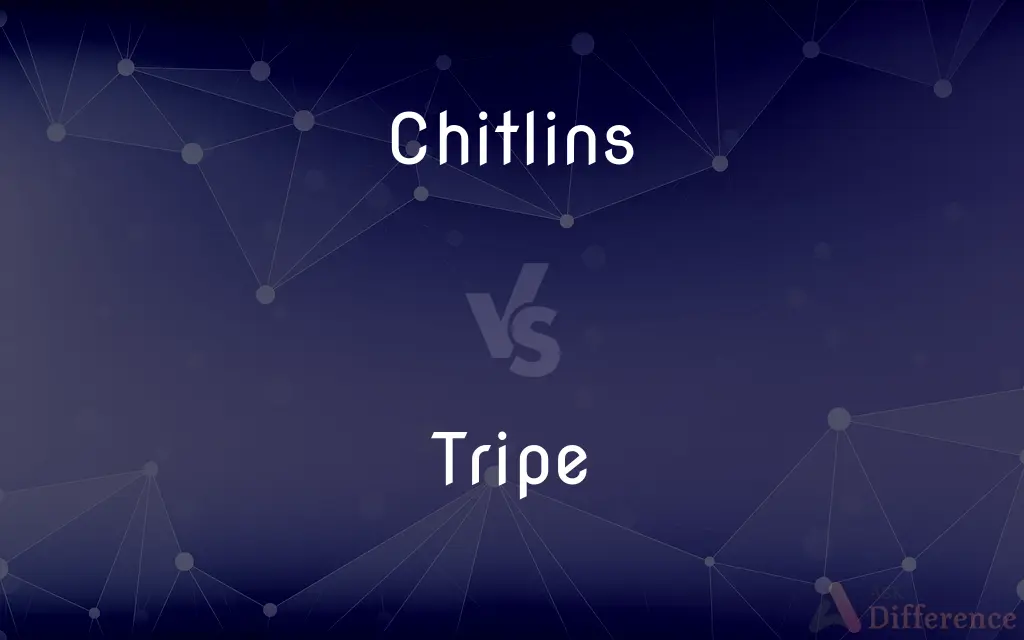Chitlins vs. Tripe — What's the Difference?
By Maham Liaqat & Fiza Rafique — Updated on March 27, 2024
Chitlins are the cleaned and cooked small intestines of pigs, while tripe is the stomach lining of various farm animals, known for distinct textures.

Difference Between Chitlins and Tripe
Table of Contents
ADVERTISEMENT
Key Differences
Chitlins, or chitterlings, are a traditional Southern and soul food delicacy made from the small intestines of pigs. They require thorough cleaning and are often boiled and then fried, offering a unique taste and chewy texture. Chitlins are celebrated in various cultures around the world, not just in the American South, but also in parts of Europe and Asia, where they are prepared in numerous ways, reflecting local culinary traditions. On the other hand, tripe is the stomach lining of ruminant animals such as cows, sheep, or goats. It is used in many cuisines globally, from Mexican menudo to Italian trippa. Tripe needs to be cleaned and cooked slowly to become tender, often featured in soups and stews to enhance its mild flavor and distinctive, somewhat rubbery texture.
While both chitlins and tripe are considered offal and have a long history in peasant cooking, they serve different culinary purposes. Chitlins are primarily valued for their texture and the flavorful broth they produce, which can be used as a base for dishes. Tripe, with its unique patterns and slightly more versatile flavor profile, absorbs the flavors of the ingredients it's cooked with, making it a favorite in rich, hearty dishes.
The preparation of both chitlins and tripe is labor-intensive, involving extensive cleaning to remove impurities and ensure safety for consumption. This process is crucial due to their origin in the digestive system of animals, where they are exposed to potentially harmful bacteria.
Both chitlins and tripe are high in protein but also in cholesterol. They offer various nutrients, including vitamins and minerals, beneficial to a balanced diet. However, their consumption is often limited by dietary preferences and cultural perceptions of offal.
Culinary traditions around chitlins and tripe reflect their adaptability and the resourcefulness of cooks in using all parts of an animal. Whether enjoyed for their taste, texture, or as a part of cultural heritage, both offer a window into the diverse world of gastronomy.
ADVERTISEMENT
Comparison Chart
Origin
Small intestines of pigs
Stomach lining of ruminant animals
Texture
Chewy
Rubber-like, tender when cooked
Culinary Uses
Boiled, then fried or used in soups
Slow-cooked in soups, stews, and other dishes
Taste
Unique, varies with preparation
Mild, absorbs flavors of cooking ingredients
Cleaning Process
Extensive, to remove impurities
Requires thorough cleaning
Nutritional Value
High in protein, high in cholesterol
High in protein, contains vitamins and minerals
Global Presence
Southern and soul food, Europe, Asia
Widely used in global cuisines
Preparation Time
Labor-intensive, lengthy cooking time
Slow cooking required for tenderness
Cultural Significance
Celebrated in various cultures
Integral to many traditional dishes worldwide
Dietary Considerations
Often limited by dietary preferences
Considered a delicacy, varies by culture
Compare with Definitions
Chitlins
The small intestines of pigs, cooked and served in various dishes.
For New Year's, she made a traditional dish of chitlins with hot sauce.
Tripe
Requires slow cooking to achieve tenderness.
She patiently prepared the tripe, knowing its tenderness would be worth the wait.
Chitlins
Celebrated in culinary traditions worldwide.
In her travels, she discovered chitlins prepared uniquely in each culture she encountered.
Tripe
The stomach lining of ruminant animals used in cooking.
The tripe was slow-cooked in a savory broth for hours, making it tender.
Chitlins
A staple in Southern and soul food cuisine.
At the family reunion, the chitlins were a favorite among the traditional soul food offerings.
Tripe
Features a distinctive, somewhat rubbery texture.
The tripe absorbed the rich flavors of the stew, offering a delightful texture contrast.
Chitlins
Require thorough cleaning before cooking.
He spent the morning cleaning the chitlins, ensuring they were ready for the pot.
Tripe
Integral to dishes like menudo and trippa.
For Sunday lunch, he made a traditional menudo with tripe that simmered all morning.
Chitlins
Known for their chewy texture.
The chitlins were so well-prepared, offering the perfect chewy bite.
Tripe
Versatile in global cuisines.
From Italian trippa to Vietnamese phở, tripe was a versatile ingredient she loved to explore in her cooking.
Chitlins
Pronunciation spelling of chitterlings
Tripe
Tripe is a type of edible lining from the stomachs of various farm animals. Most tripe is from cattle, pigs and sheep.
Chitlins
Small intestines of hogs prepared as food
Tripe
The rubbery lining of the stomach of cattle or other ruminants, used as food.
Tripe
(Informal) Something of no value; rubbish.
Tripe
The lining of the large stomach of ruminating animals, when prepared for food.
Tripe
The entrails; hence, humorously or in contempt, the belly.
Tripe
Something foolish or valueless, especially written works and popular entertainment (movies, television).
Tripe
An edible lichen, especially rock tripe.
Tripe
(pejorative) That (what has just been said) is untrue.
Tripe
The large stomach of ruminating animals, when prepared for food.
How say you to a fat tripe finely broiled ?
Tripe
The entrails; hence, humorously or in contempt, the belly; - generally used in the plural.
Tripe
Lining of the stomach of a ruminant (especially a bovine) used as food
Tripe
Nonsensical talk or writing
Common Curiosities
Is it safe to eat chitlins and tripe?
Yes, when properly cleaned and cooked, both are safe to eat, though they require thorough preparation to remove bacteria.
Are chitlins and tripe considered healthy?
They are high in protein but also high in cholesterol; moderation is key, as with all offal.
How long does it take to cook chitlins and tripe?
Both require lengthy cooking times—chitlins to ensure they are clean and tender, and tripe to achieve the desired tenderness.
How do cultural perceptions of chitlins and tripe vary?
While considered delicacies in some cultures, in others, they may be viewed with skepticism due to their origins.
Can chitlins or tripe be made crispy?
Chitlins can be fried for a crispy texture, whereas tripe tends to remain softer, even when cooked for long periods.
Can chitlins and tripe be prepared in a similar manner?
While both require extensive cleaning, their cooking methods often differ to highlight their unique textures and flavors.
Why do chitlins and tripe have a strong smell during cooking?
Their origin in the digestive system means they can have a strong smell, but proper cleaning and cooking methods can minimize this.
What are the best spices to use with chitlins and tripe?
Both can be flavored with a variety of spices, from hot sauce and vinegar for chitlins to aromatic herbs and spices for tripe.
Are there cultural festivals dedicated to chitlins or tripe?
Yes, there are festivals and celebrations that honor these foods, highlighting their cultural significance in various communities.
What are common misconceptions about chitlins and tripe?
Misconceptions include concerns about safety and taste, but proper preparation can make them delicious and safe to eat.
Can you substitute chitlins for tripe in a recipe?
Due to their distinct textures and flavors, they are not ideal substitutes for each other in recipes.
Can chitlins or tripe be frozen?
Yes, both can be frozen for extended storage, though they should be thoroughly defrosted and cooked properly afterward.
Where can I buy chitlins and tripe?
Both can be found in butcher shops, specialty stores, and some supermarkets, especially those catering to diverse cuisines.
How do you store leftover chitlins and tripe?
Both should be stored in airtight containers in the refrigerator and consumed within a few days for safety and freshness.
What are the key factors in preparing delicious chitlins and tripe?
Thorough cleaning, proper seasoning, and patient cooking are essential for bringing out the best in both chitlins and tripe.
Share Your Discovery

Previous Comparison
Oba vs. Soba
Next Comparison
Musk vs. MaskAuthor Spotlight
Written by
Maham LiaqatCo-written by
Fiza RafiqueFiza Rafique is a skilled content writer at AskDifference.com, where she meticulously refines and enhances written pieces. Drawing from her vast editorial expertise, Fiza ensures clarity, accuracy, and precision in every article. Passionate about language, she continually seeks to elevate the quality of content for readers worldwide.














































